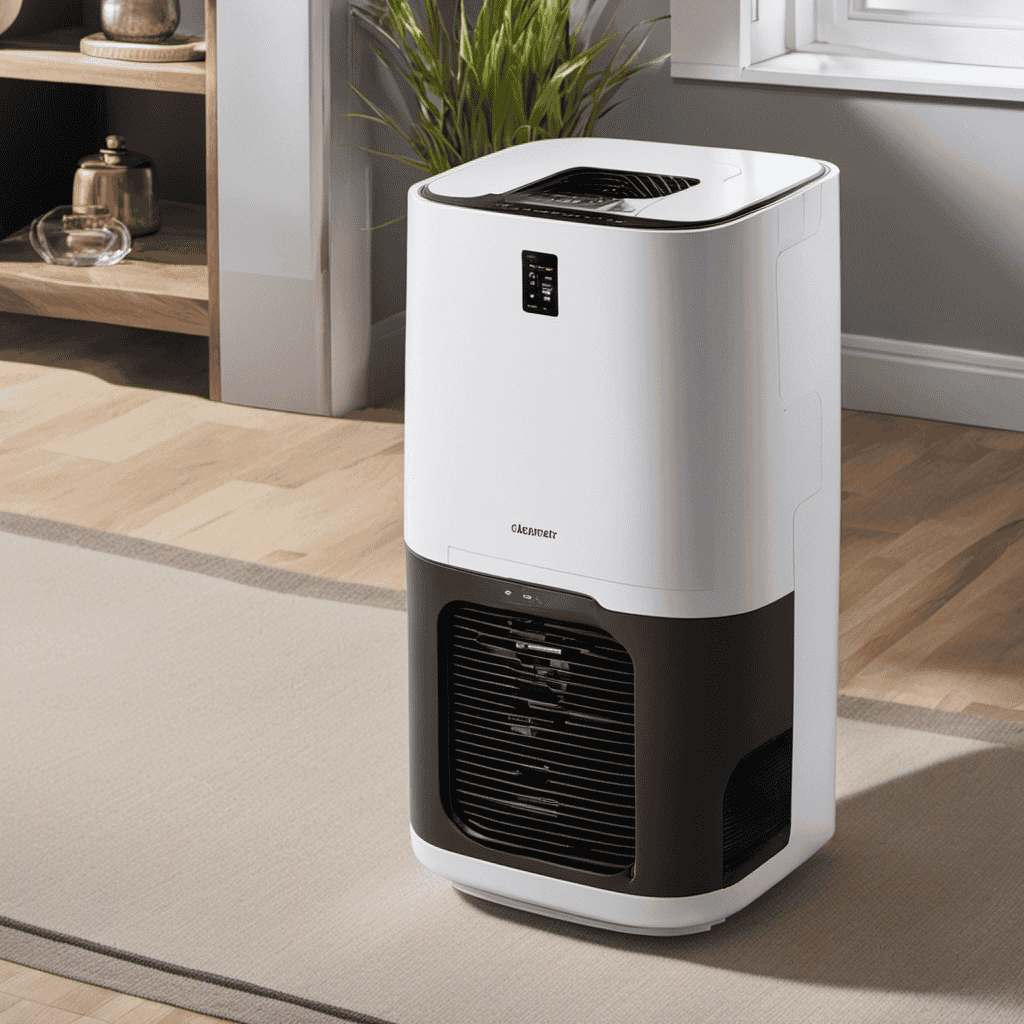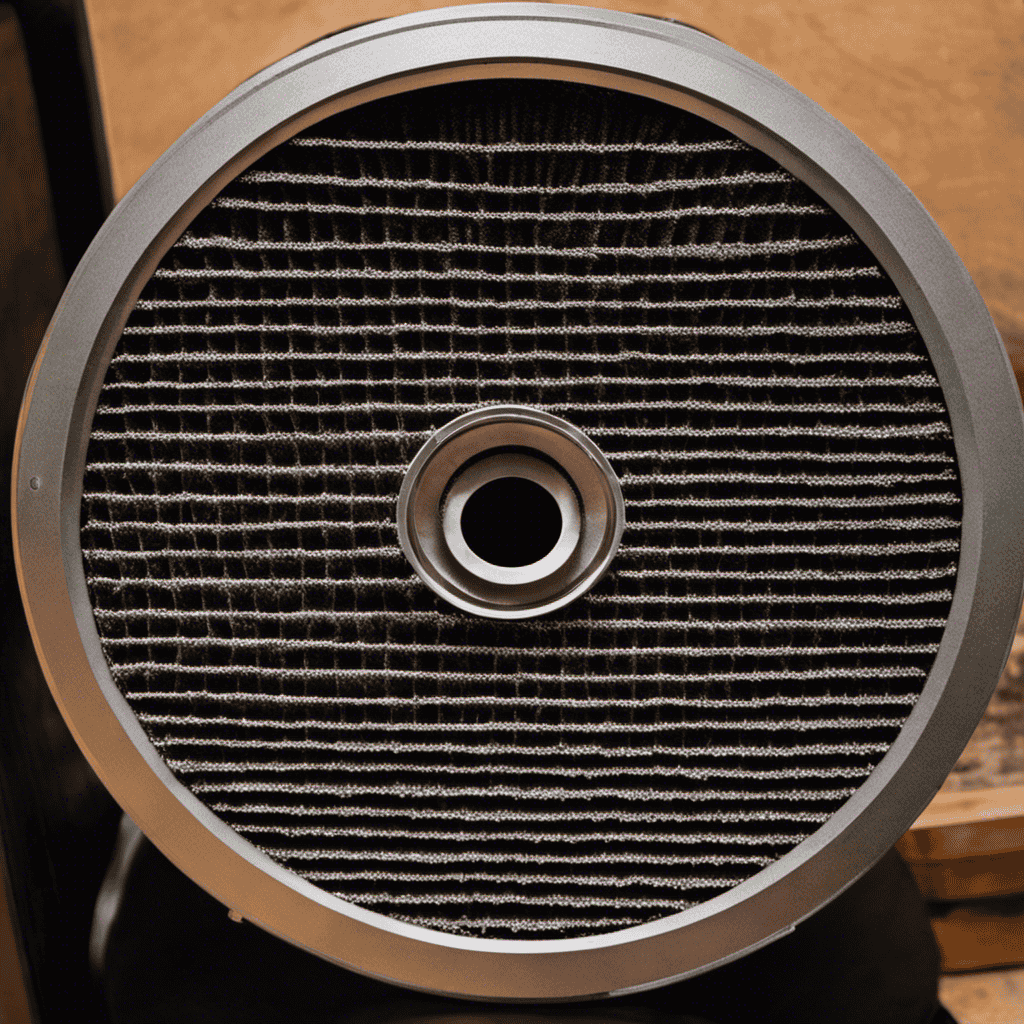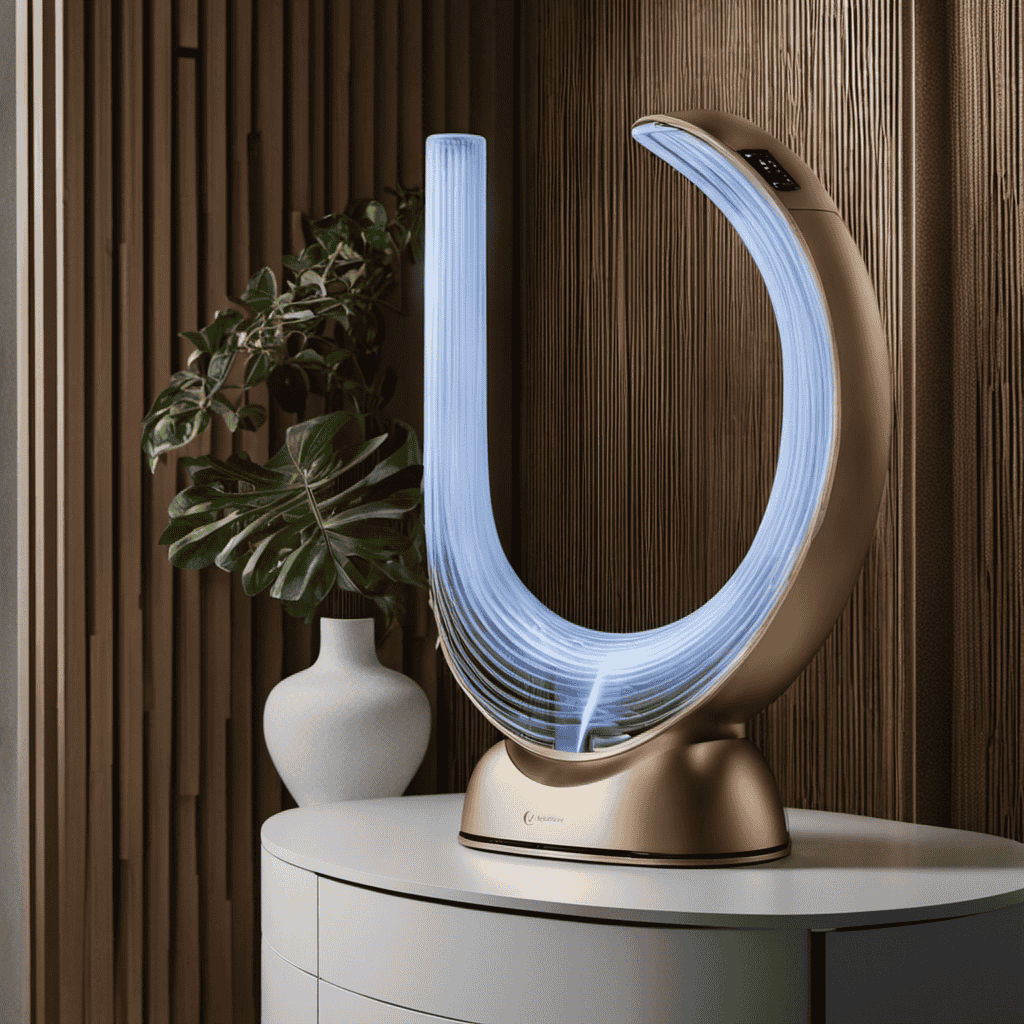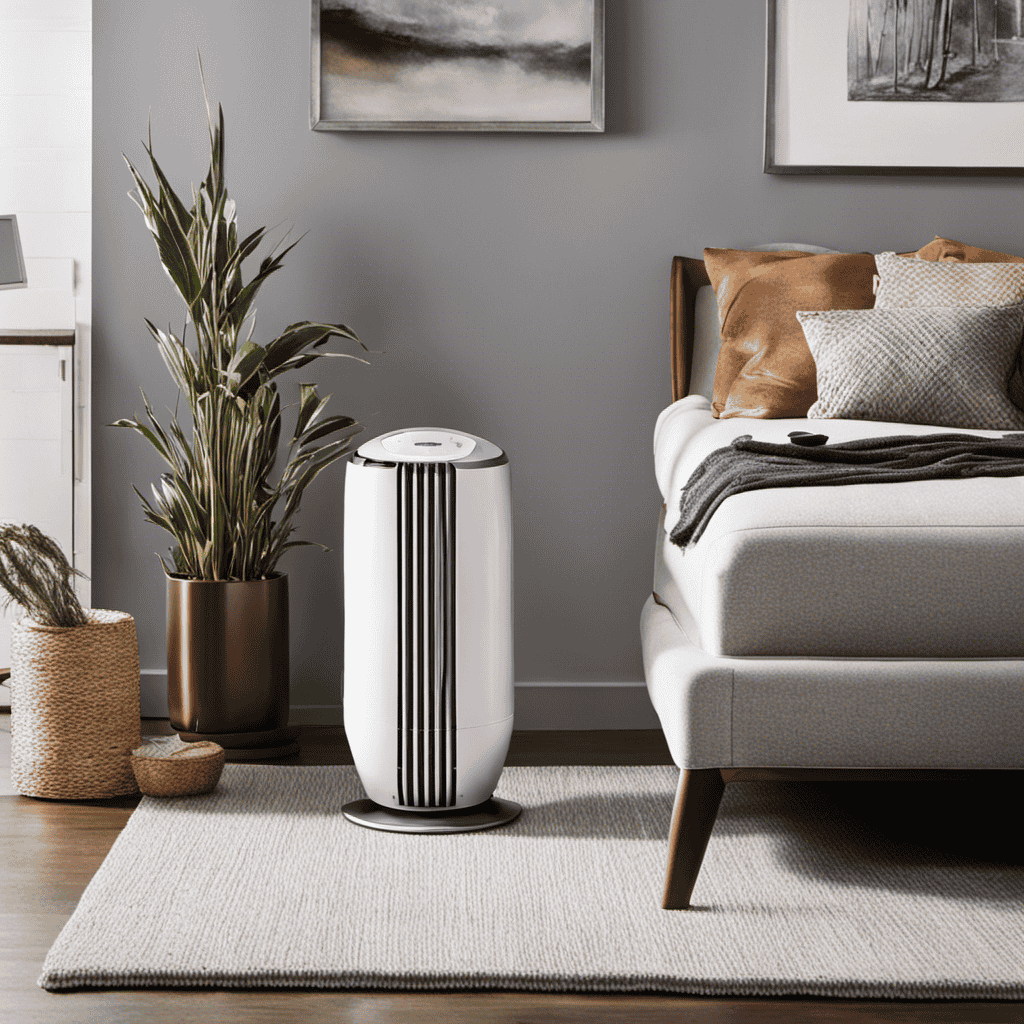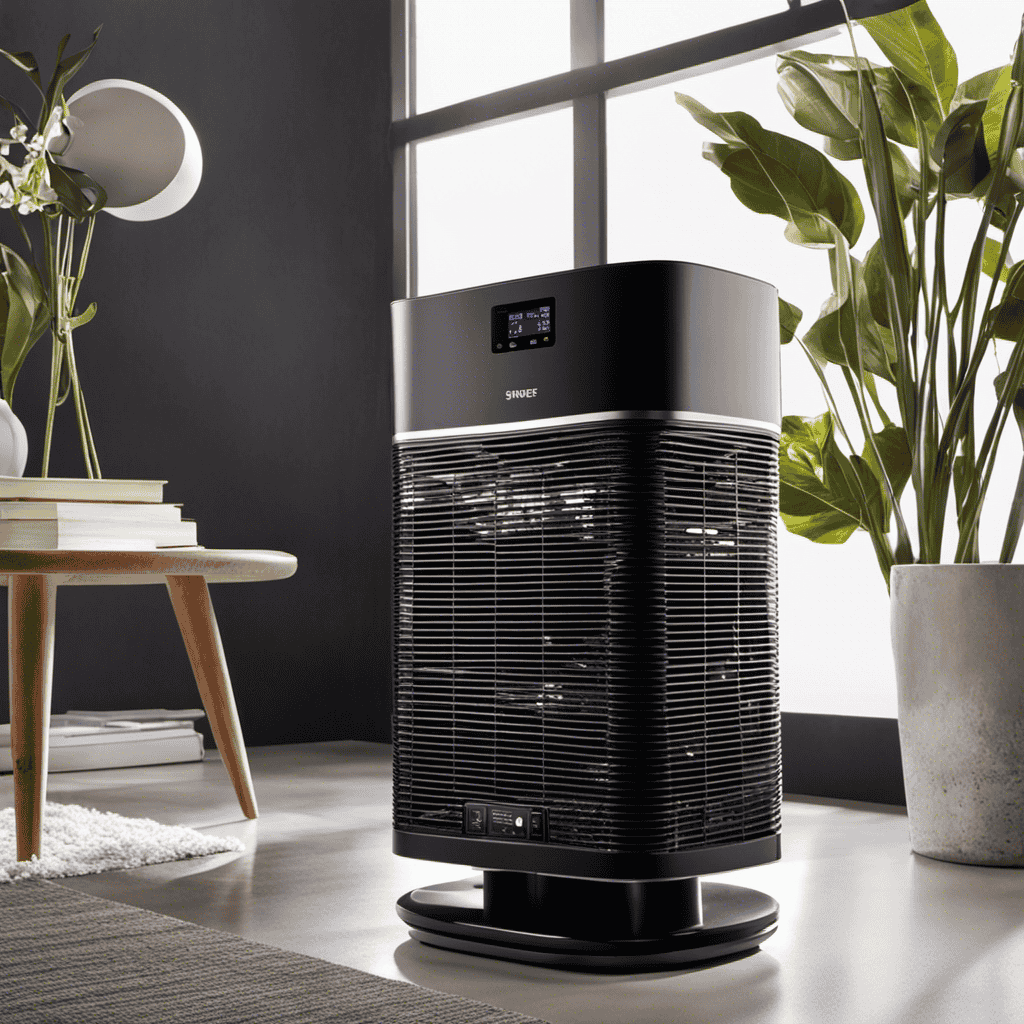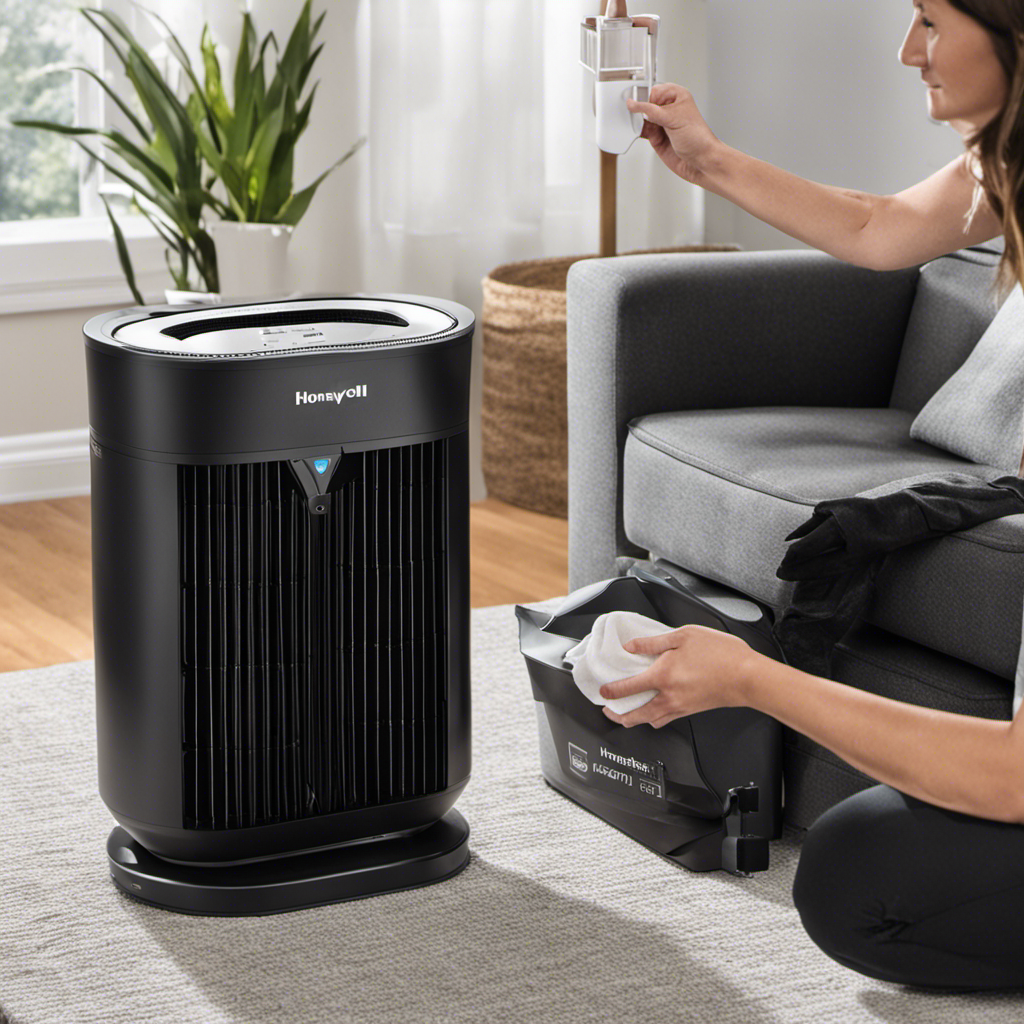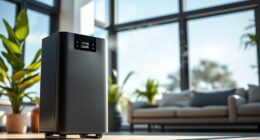I’ve always been curious about the best way to clean my air purifier in my home. This appliance is vital for ensuring that my family breathes clean and fresh air. After conducting some research, I have compiled an informative article on “How to Clean My Living Air Purifier”.
In this guide, I’ll walk you through the step-by-step process of cleaning the filters, maintaining the exterior, and keeping the fan and motor in top shape.
Let’s get started on creating a healthier living environment together!
Key Takeaways
- The Living Air Purifier has different filters that capture larger particles, remove odors and harmful chemicals, and capture tiny particles.
- The purifier’s fan circulates purified air back into the room.
- Proper cleaning of the filters and exterior of the purifier is necessary to maintain performance.
- It is important to use mild, non-abrasive cleaning products and follow the manufacturer’s instructions for cleaning and drying the filters.
Understanding the Parts of Your Living Air Purifier
Before you begin cleaning your living air purifier, it’s important to understand the different parts of the device. This knowledge will help you maintain its performance and troubleshoot common issues.
The main components of an air purifier include the pre-filter, activated carbon filter, HEPA filter, and the fan. The pre-filter is responsible for capturing larger particles like dust and pet hair. The activated carbon filter helps remove odors and harmful chemicals from the air. The HEPA filter is the most important part, as it captures tiny particles like pollen and bacteria. The fan then circulates the purified air back into the room.
Preparing for the Cleaning Process
To get ready for the cleaning process, you’ll want to gather all the necessary supplies. Here are the items you’ll need:
-
Cleaning products: Make sure to use mild, non-abrasive cleaners that are specifically recommended for air purifiers. Avoid using harsh chemicals to prevent damage to the unit.
-
Soft cloth or brush: Use a soft cloth or brush to gently wipe away dust and dirt from the exterior and interior surfaces of the purifier. Avoid using abrasive materials that could scratch the surface.
-
Water: You may need to use water to rinse the filters or other removable parts of the purifier. Follow the manufacturer’s instructions to determine if water is safe to use and the best method for cleaning.
-
Troubleshooting guide: Keep a troubleshooting guide handy in case you encounter any common issues during the cleaning process. This will help you quickly resolve any problems and ensure the purifier is working effectively.
Removing and Cleaning the Filters
After gathering the necessary supplies, you’ll want to start removing and cleaning the filters of your purifier.
The first filter to address is the pre-filter. This filter is responsible for capturing large particles like dust and pet hair. To clean it, simply remove the pre-filter from the purifier and gently brush off any visible debris. If the pre-filter is heavily soiled, you can rinse it with water and mild soap. Allow it to air dry completely before reinserting it into the purifier.
Next, you’ll need to clean the ionizer. This component is responsible for generating negative ions to attract and neutralize airborne particles. To clean the ionizer, gently wipe it with a soft, dry cloth to remove any dust or dirt buildup. Be careful not to damage the delicate ionizer wires.
Following these steps will ensure that your purifier continues to effectively clean the air in your home.
Cleaning the Exterior of the Air Purifier
When it comes to cleaning the exterior of your air purifier, it’s important to use proper cleaning techniques to ensure its longevity and effectiveness.
Regularly cleaning the exterior not only enhances its appearance but also helps maintain its performance.
It is recommended to clean the exterior of your air purifier at least once a month to remove dust, dirt, and other particles that may accumulate on the surface.
Additionally, avoiding potential damage is crucial by using gentle cleaning agents and avoiding abrasive materials that can scratch or damage the unit.
Proper Cleaning Techniques
Make sure you regularly clean the filters of your living air purifier to maintain its effectiveness. Cleaning the filters is an essential part of maintaining the overall performance of your air purifier. Here are some proper cleaning techniques to keep in mind:
- Use a cleaning solution specifically designed for air purifiers to ensure thorough cleaning.
- Gently remove the filters from the purifier and submerge them in the cleaning solution.
- Allow the filters to soak for the recommended amount of time.
- After soaking, rinse the filters thoroughly with clean water to remove any residue.
Once you have completed the cleaning process, it is crucial to let the filters dry completely before reinstalling them into the air purifier. This ensures that the filters are free from moisture, preventing the growth of mold or bacteria.
Following these proper cleaning techniques will help optimize the performance of your living air purifier. Now, let’s discuss the recommended cleaning frequency.
Recommended Cleaning Frequency
It’s important to regularly maintain your air purifier by cleaning the filters in order to ensure its optimal performance. Cleaning frequency may vary depending on factors such as the air quality in your environment, the type of filter, and the manufacturer’s recommendations.
As a general guideline, it is recommended to clean the filters every three to six months. However, it is crucial to monitor the signs of a dirty air purifier to determine if cleaning is needed sooner. Signs of a dirty air purifier include decreased airflow, visible dust or debris on the filters, and a noticeable decrease in the air purifier’s effectiveness.
When cleaning your air purifier, it is important to use recommended cleaning products specified by the manufacturer to avoid damaging the filters or compromising the device’s performance.
Avoiding Potential Damage
To prevent potential damage, be sure to follow the manufacturer’s guidelines for cleaning and maintenance. It is crucial to take necessary precautions when cleaning your living air purifier to avoid electrical issues and water damage. Here are some key tips to keep in mind:
- Always unplug the air purifier before cleaning to prevent any electrical accidents.
- Use a soft, dry cloth or a microfiber cloth to gently wipe the exterior of the purifier.
- Avoid using any liquid cleaners directly on the unit as they can seep into the electrical components and cause damage.
- If you notice any liquid spills on the purifier, immediately turn it off, unplug it, and let it dry completely before using it again.
By following these guidelines, you can ensure the longevity and optimal performance of your air purifier.
Now, let’s move on to maintaining the fan and motor.
Maintaining the Fan and Motor
When it comes to maintaining the fan and motor of an air purifier, there are a few key points to keep in mind.
Firstly, regular cleaning of the fan blades is essential to ensure optimal performance. This can be done by gently wiping the blades with a soft cloth or using a vacuum cleaner with a brush attachment.
Secondly, preventing motor overheating is crucial to prolonging the lifespan of the air purifier. This can be achieved by ensuring proper airflow around the unit, keeping it away from obstructions, and avoiding running the purifier for extended periods of time without breaks.
Cleaning Techniques for Fan
To clean the fan on your living air purifier, you can use a soft brush or cloth to gently remove any dust or debris. It is important to regularly clean the fan to ensure optimal performance and prevent any potential issues.
Here are some tips for cleaning your air purifier’s fan:
- Turn off the air purifier and unplug it from the power source before cleaning.
- Use a soft brush or cloth to remove dust and debris from the fan blades.
- Be careful not to apply too much pressure, as this could damage the fan.
- If necessary, you can also use compressed air to blow away any stubborn dust particles.
By following these cleaning techniques, you can maintain the fan of your living air purifier and troubleshoot any fan issues that may arise.
Now, let’s move on to the next section about preventing motor overheating.
Preventing Motor Overheating
Regular maintenance is crucial for preventing motor overheating in your air purifier. Neglecting to properly care for your purifier’s motor can lead to costly repairs and reduced performance. To help you prevent motor damage and troubleshoot any motor issues, here are some important tips:
-
Clean the motor regularly: Dust and debris can accumulate on the motor, inhibiting its ability to function properly. Use a soft brush or compressed air to remove any buildup.
-
Check the motor bearings: Over time, the motor bearings may wear out or become misaligned. Inspect them regularly and replace them if necessary to prevent overheating.
-
Ensure proper ventilation: Adequate airflow is essential for preventing motor overheating. Make sure that the air intake and exhaust vents are clean and unobstructed.
-
Monitor the motor temperature: If you notice that the motor feels excessively hot to the touch, it may be overheating. Turn off the purifier and allow it to cool down before using it again.
Reassembling and Testing Your Air Purifier
First, make sure you have reassembled your air purifier correctly before testing it. Proper reassembly is crucial to ensure the device functions optimally and effectively improves indoor air quality.
To test your air purifier, follow these methods and troubleshooting techniques:
-
Power On Test: Plug in the air purifier and turn it on. Check if the power indicator light illuminates, indicating that it is receiving electricity.
-
Fan Speed Test: Adjust the fan speed settings and observe if the air purifier responds accordingly. The fan should increase or decrease its speed based on the selected setting.
-
Filter Status Test: Monitor the filter status indicator to ensure it is functioning correctly. If the indicator shows a need for replacement, follow the manufacturer’s guidelines.
-
Air Quality Test: Use an air quality monitor to measure the improvement in air quality after running the air purifier for a specific period.
By following these testing methods and troubleshooting techniques, you can ensure your air purifier is in proper working condition and ready to provide clean and fresh air.
Now, let’s move on to the next section to learn some regular maintenance tips to keep your air purifier clean.
Regular Maintenance Tips to Keep Your Air Purifier Clean
Make sure you regularly check and replace the filters in your air purifier to maintain its optimal performance.
Cleaning solutions and troubleshooting tips are essential for keeping your air purifier clean.
To clean the filters, start by turning off the purifier and unplugging it from the power source.
Gently remove the filters and check for any visible dirt or debris. If necessary, use a vacuum cleaner or a soft brush to remove the particles.
For a deeper clean, you can also soak the filters in a solution of warm water and mild detergent.
After cleaning, make sure the filters are completely dry before reinserting them into the purifier.
Additionally, troubleshooting tips such as checking the power supply, ensuring proper placement, and resetting the device can help resolve any issues you may encounter.
Regular maintenance is key to ensuring your air purifier functions optimally and provides clean and fresh air for your home.
Frequently Asked Questions
How Often Should I Clean My Living Air Purifier?
I clean my living air purifier regularly to maintain its efficiency. Based on my research, it is recommended to clean the HEPA filter every 3-6 months and replace it annually for optimal performance.
Can I Use Soap and Water to Clean the Filters?
I wouldn’t recommend using soap and water to clean the filters of your living air purifier. It’s best to use cleaning solutions specifically designed for air purifiers or follow alternative cleaning methods recommended by the manufacturer.
Is It Safe to Clean the Exterior of the Air Purifier With a Damp Cloth?
Yes, it is safe to clean the exterior of the air purifier with a damp cloth. Regular cleaning is important for optimal performance and using a damp cloth is a proper technique for maintenance.
Should I Clean the Fan and Motor Separately or Together?
I clean the fan and motor separately as it allows for a more thorough cleaning. Common mistakes include not using the proper cleaning techniques and not removing any accumulated debris.
What Should I Do if My Air Purifier Is Not Working Properly After Cleaning?
If my air purifier is not working properly after cleaning, I would troubleshoot common air purifier problems. This could include checking the power source, replacing filters, or contacting the manufacturer for further assistance.
Conclusion
In conclusion, cleaning your living air purifier is a crucial step in ensuring its optimal performance and longevity. By understanding its parts, preparing for the cleaning process, and properly cleaning the filters, exterior, fan, and motor, you can maintain a clean and healthy environment in your home.
Regular maintenance is key to keeping your air purifier in top shape, so don’t neglect this important task. With a little effort and time, you can enjoy the benefits of clean and fresh air for years to come.
